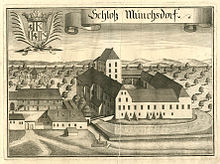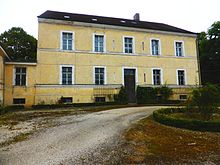Münchsdorf Castle

The Münchsdorf castle located in the district Münchsdorf the Lower Bavarian village of Rossbach in the district of Rottal-Inn of Bavaria (Schloßhof 1).
history
Before 1380 Münchsdorf was owned by the Counts of Ortenburg , the property came from the Counts of Hals , of whom the daughter of Alram von Hals had married Count Heinrich IV von Ortenburg and received Münchsdorf as a marriage property . In 1370 Münchsdorf was given to Friedrich Stachel von Stacheleck as a pledge. In 1411 Beatrix, the daughter of Friedrich von Stacheleck, inherited Münchsdorf from her brother. Since she was married to Gebhard von Camer, Münchsdorf subsequently came to the Lords of Camer . Müchsdorf went as the Ortenburg fiefdom to the cousins of Camer, namely to Wolfgang von Tannberg, cathedral dean of Passau , and his brother Andre von Tannberg. After the death of Wolfgang († around 1527) the fief fell to the noble and Vesten Andre and the Seiboldsdorfer, who were related to the Tannbergers . Count Christoph von Ortenburg had a compromise reached in 1533, according to which Erasm von Seiboldsdorf had to deposit a certain sum for Wolfgang's share. There was a serious error about the granting of fiefs , because Erasm († 1547) only wanted to recognize the Veste and Hofmark Münchsdorf as a local fiefdom and not the other rights and associated court brands. These claims have been at least partially recognized. A letter of will from Count Joachim von Ortenburg in 1569 states that the Münchsdorf castle and fortress were lent to Veit Erasm von Seiboldsdorf. In 1592 the Seiboldsdorfer still held Münchsdorf. Since there were no male heirs after the death of Veit Erasm, the widow Maria Jakoba from Münchsdorf zu Seibersdorf asked for the fief and was granted it in 1595. After her death († January 23, 1599) Münchsdorf passed as a fiefdom to Wolfgang von Wildenstein (husband of Polixenia von Münchau) and his brother-in-law Constantin von Münchau. After his death (he drowned in the Kollbach in 1606 ) the Hofmark was handed over to his sister Anna von Buchholz (née von Münchau) (she did not live here, however, but in the Palatinate ); In 1619 her daughter took her place here. After her death († July 18, 1633), her cousin Georg Christoph Freiherr von Closen asked to be awarded the Hofmark and her pertinence . However, in 1636 the Ortenburgers gave another, namely the noble Johann Mändl zu Deutenkofen, the preference against payment of a compensation and a loan purchase . In 1639 Johann Mändl got Münchsdorf Castle with its court stamps as an allodial possession .
In 1816, Baron Anton von Mändl sold the property to the widowed Countess von Deroi, born Freiin von Hertling. This sold the property to Freiherr von Tautphöus, government vice-president of the royal government of the Lower Danube district. It was bought by the royal government director Georg Ritter von Greiner from his family around 1837, from whom it soon came to the state councilor von Maurer. In the middle of the 19th century Münchsdorf came to the barons of Aretin . From 1820 to 1848 there was a second class patrimonial court in Münchsdorf . The barons of Aretin still own the castle today. In the nearby cemetery is the grave of the writer and monarchist Erwein von Aretin , member of the German Nobility Law Committee . After the Second World War , the Münchsdorf Castle Refugee Home was housed here.
Münchsdorf Castle then and now
After the engraving by Michael Wening , Münchsdorf Castle was a two to three-storey four-wing complex within a moat in 1721. A four- story , palas-like building can be seen in the inner courtyard . A bridge leads over the moat, outside are the farm buildings of the castle. After the old castle was demolished (1836/1837), the castle nursery was housed there until 1979.
Today's two-storey building is in poor structural condition, although renovation efforts can be seen (roof coverings). It forms a square complex with a main house with a gable roof from the first third of the 19th century. In the middle of the front is a portal that leads directly to the stairwell. The main building is a simple two-story eaves side building with a flat hipped roof. Two lower farm buildings from the 18th and 19th centuries belong to the castle. These form a courtyard with the main house on the north side. A large former farmyard is located east of the castle; it consists of a two-storey hipped roof building on the north side from the mid-19th century, but the core is probably older. A single-storey, hook-shaped building with a high crooked roof is located in the south and east, also from the 18th and 19th centuries. The palace garden (from the 19th century) is located on the south side of the palace and still contains the remains of the former moat.
The palace complex is surrounded by a nursery.
literature
- Ilse Louis: Parish churches. The nursing courts Reichenberg and Julbach and the rule Ering-Frauenstein. (= Historical Atlas of Bavaria , part of Old Bavaria, issue 31). Michael Laßleben Verlag, Munich 1973 (pp. 287-290). ISBN 3-7696-9878-9 .
Web links
- Entry on Münchsdorf Castle in the private database "Alle Burgen".
- Münchsdorf Castle at the Institute for German Nobility Research
- Local history Münchsdorf near the community of Roßbach
Individual evidence
Coordinates: 48 ° 35 ′ 17.7 " N , 12 ° 54 ′ 11.5" E



